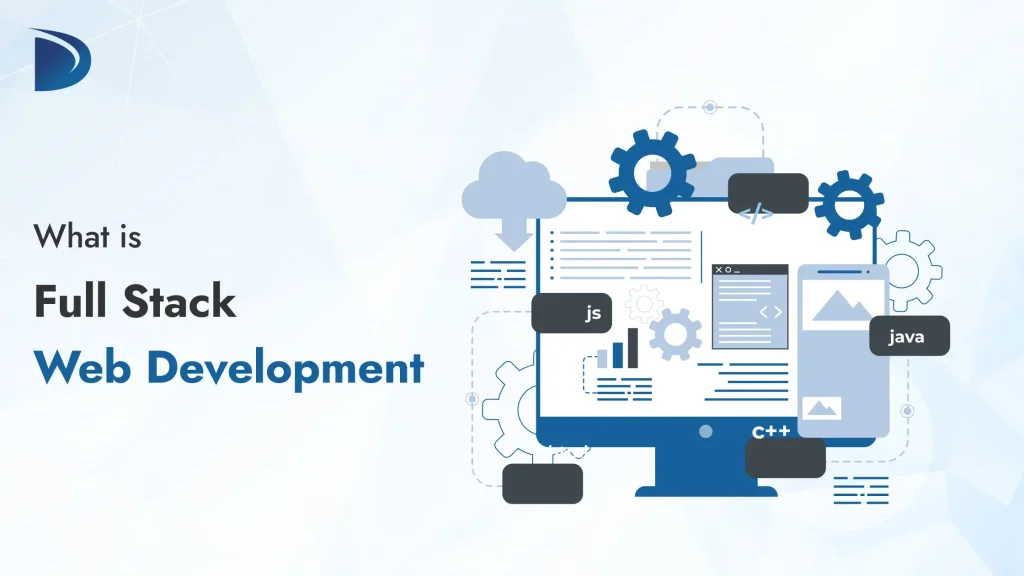Table of Contents
Full stack web development means building both parts of a web app: the front end (what users see) and the back end (how the app works behind the scenes). In simple words, a full-stack developer designs screens, writes server logic, works with databases, and ships features to the cloud. This guide will help you understand what full stack development is, what full stack developers do, which tools they use, and how to start learning this exciting skill.
How the Web Works
Your browser asks a server for a page. The server returns HTML, CSS, and JavaScript. The page may call a RESTful API or GraphQL to get data. The browser renders the UI; the server handles rules, data, and security. Full-stack developers connect these parts so the app is fast, safe, and simple to use.
Front End: What Users See and Use
Front end development focuses on the user interface (UI) and user experience (UX). It must look good, be easy to use, and work on phones, tablets, and desktops.
Tools & technologies
- HTML – builds the structure of pages
- CSS – styles (colors, fonts, spacing)
- JavaScript – makes pages interactive (menus, sliders, validation)
Popular frameworks/libraries
- React.js – fast, component-based, great community
- Angular – full framework by Google
- Vue.js – lightweight and beginner-friendly
Typical responsibilities
- Designing user-friendly screens and UI components
- Making responsive layouts
- Ensuring accessibility and cross-browser support
- web performance optimization (faster loads, code-splitting, image compression)
Back End: Logic, Data, and Integrations
Back end development powers everything behind the UI. It manages data, rules, and connections to other systems.
Languages & runtimes
- Node.js (JavaScript), Python, PHP, Java, Ruby
Frameworks
- Express.js (Node.js), Django (Python), Laravel (PHP), Spring Boot (Java), Rails (Ruby)
Databases
- MySQL, PostgreSQL, MongoDB, Firebase
Servers & APIs
- Nginx, Apache
- RESTful API, GraphQL
Typical responsibilities
Handling user accounts and authentication and authorization
- Storing and managing data
- Creating APIs for the front end to use
- Securing the site from threats and abuse
Databases & Storage: Picking the Right Model
Your choice affects speed and scale.
- Relational (SQL): PostgreSQL, MySQL strong consistency, joins, transactions.
- NoSQL: MongoDB, Firebase flexible schema, great for fast iteration.
- Caching: Redis speeds up frequent reads, sessions, queues.
Use ORMs (Prisma, TypeORM, Sequelize) or query builders to manage schemas and migrations. When choosing, compare SQL vs NoSQL databases based on data shape, queries, and growth plans.
Popular Full-Stack Tech Stacks
A “stack” is the set of tools you combine to build an app.
| Stack Name | Front-End | Back-End | Database |
|---|---|---|---|
| MERN | React.js | Node.js + Express | MongoDB |
| MEAN | Angular | Node.js + Express | MongoDB |
| LAMP | HTML/CSS/JS | PHP | MySQL |
| Django | HTML/CSS/JS | Python + Django | PostgreSQL |
What a Full-Stack Developer Does (Day to Day)?
A full-stack developer can build a feature end-to-end:
- Designing UI with HTML, CSS, and JavaScript
- Writing server logic in Node.js, Python, PHP, etc.
- Connecting the app to a database
- Testing and fixing bugs
- Deploying to a live server
- Maintaining and improving the app over time
They often own small projects from idea to production, which is why full stack web development is so valuable for startups and MVPs.
Why Learn Full Stack? (Clear Benefits)
| Benefit | Explanation |
|---|---|
| Versatility | You can work on both front and back end |
| High Demand | Many teams need full-stack developers |
| Cost-Saving | One person can cover multiple roles |
| Project Ownership | Build complete apps on your own |
| Better Understanding | See how all parts fit together |
These advantages make full-stack a strong career choice and a smart capability for small teams.
DevOps & Deployment: Getting Code Online
Building features is half the job; delivering them safely is the other half.
- Versioning & releases with CI/CD pipelines (GitHub Actions, GitLab CI)
- Containerization with Docker; orchestration with Docker and Kubernetes when you need scale
- Hosting options: Vercel, Netlify (front end); Render, Fly.io, Heroku, DigitalOcean, or AWS (back end)
- Observability: logs, metrics, traces; uptime checks and alerts
- Security basics: environment secrets, firewalls/WAF, HTTPS and TLS
This is the heart of DevOps for web apps moving fast without breaking things.
Security Basics You Should Not Skip
- Validate and sanitize inputs; escape outputs to prevent XSS
- Use HTTPS everywhere; set secure cookies and HSTS
- Hash passwords with bcrypt/Argon2; rotate secrets
- Add rate limiting and CSRF protection
- Follow OWASP Top 10 and least-privilege access rules
Testing & Quality: Shipping With Confidence
- Unit tests for small pieces of logic
- Integration tests for modules working together
- End-to-end tests for real user flows (Cypress, Playwright)
- Accessibility checks and visual regression tests
- Keep tests in your CI/CD pipelines so bugs get caught early
Performance & Scalability (Simple Rules That Work)
- Client side: code-split, lazy-load images, prefetch routes, measure Core Web Vitals
- Server side: add caching (HTTP headers, Redis), profile hot paths
- Data: add correct indexes, avoid N+1 queries, consider read replicas
- Workloads: move heavy tasks to background jobs and queues
These habits fall under web performance optimization and make users and Google happier.
How to Become a Full-Stack Developer (Step-by-Step)?
- Learn the basics
HTML, CSS, and JavaScript. Build simple pages and forms. - Pick a front-end framework
Choose React, Angular, or Vue. Learn components, state, and events. - Choose a back-end language
Start with Node.js, Python, or PHP. Build a RESTful API to handle user data. - Work with databases
Practice storing and retrieving data using MongoDB or MySQL; compare SQL vs NoSQL databases. - Build real projects
Blog, to-do app, notes app, or a small e-commerce cart. Combine front and back ends in one project. - Understand deployment
Host with Netlify or Vercel (front end) and Render/Heroku/DigitalOcean/AWS (back end). Add CI/CD pipelines. - Use team tools
Learn version control with Git, branching, and pull requests. Write short, clear commits. - Keep learning
Follow tutorials, join communities, contribute to open source, and improve your portfolio. Consider a full stack web development for structure and feedback.
A Simple End-to-End Workflow (What “Full-Stack” Looks Like)
- Plan: define the problem, users, and success metrics.
- Design: wireframes and UI components; agree on API contracts.
- Build front end: pages, forms, routing, accessibility.
- Build back end: endpoints, services, models, API development details.
- Integrate: connect UI ↔ RESTful API; handle loading and error states.
- Test: unit, integration, E2E, and accessibility.
- Deploy: ship through CI/CD pipelines; watch logs and metrics; iterate.
Conclusion
Full stack web development is about creating real, user-friendly, data-driven apps from start to finish. You design interfaces, build secure services, choose between SQL vs NoSQL databases, expose a clean RESTful API, and deliver changes quickly with DevOps for web apps and CI/CD pipelines.
If you’re learning, try a structured full stack web development and build a few projects. If you’re shipping a product and want speed, you might hire full stack developer talent or an agency for full stack development services.
FAQs
Which stack should I start with?
The MERN stack is popular for beginners because you use JavaScript everywhere. PERN (PostgreSQL + Express + React + Node) is also great.
Do I need Kubernetes at the start?
No. Learn Docker and automated deploys first. Add Docker and Kubernetes later when your app needs scale.
Front end or back end first?
Either is fine. Many people start with the front end because results are visual, then add the back end.
What is full stack web development?
It means building both the front end (what users see) and the back end (servers, databases, APIs) of a web app. A full-stack dev can ship features end-to-end.
Which language should I start with?
JavaScript is a common choice because you can use it on both the client and server (Node.js). Python and PHP are also beginner-friendly on the back end.
What is a RESTful API and why is it popular?
It’s a common way to build web services using HTTP methods (GET/POST/PUT/DELETE), usually with JSON. It’s simple, stateless, and widely supported.
REST vs GraphQL: which should I learn?
Learn REST first (it’s everywhere). Use GraphQL when clients need flexible queries or to reduce over/under-fetching of data.
How do I handle authentication and authorization?
Use secure password hashing, sessions or JWT, and role/permission checks on protected routes. Add rate limits and input validation. Follow OWASP basics.

